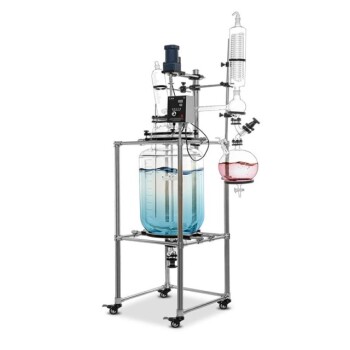Rotary evaporators are essential tools in laboratories for solvent removal and concentration processes. To improve their performance, several strategies can be employed, ranging from proper maintenance practices to upgrading with advanced features. Maintaining a sealed system, handling glassware carefully, and ensuring proper water levels in the heating tank are fundamental steps. Additionally, understanding factors like vacuum degree, cooling water temperature, and steam temperature can significantly enhance efficiency. Upgrading with features such as automatic vacuum control, dual condensers, and digital displays can further optimize performance. Regular cleaning and preventive measures, such as using distilled water and avoiding grease on ground glass joints, also contribute to longevity and reliability.
Key Points Explained:

-
Proper Maintenance Practices
- Sealing the System: Ensuring the equipment is sealed is crucial for maintaining vacuum integrity and preventing contamination. This helps in achieving efficient solvent removal and maintaining the purity of extracted solvents.
- Handling Glassware: Gentle handling of glass components, along with proper washing and drying, prevents damage and ensures longevity.
- Heating Tank Care: Always fill the heating tank with water before turning it on to avoid dry burning, which can damage the equipment.
-
Optimizing Efficiency
- Vacuum Degree and Cooling Water Temperature: A high vacuum degree and low cooling water temperature are critical for increasing the evaporation rate. These factors directly influence the efficiency of solvent removal.
- Steam Temperature: Adjusting the steam temperature to an optimal level ensures faster evaporation without compromising the sample integrity.
-
Upgrading with Advanced Features
- Automatic Vacuum Control: Adding automatic vacuum control systems can enhance throughput and maintain consistent product quality.
- Dual Condensers: Installing dual condensers allows for larger solvent volumes to be condensed, reducing processing time.
- Digital Displays: Digital displays for temperature and vacuum control enable precise and repeatable experiments, improving accuracy.
- Power Lifting Motors: These motors make handling the boiling flask easier, especially when dealing with large volumes.
-
Operational Best Practices
- Flask Capacity: Ensure the round-bottom flask is no more than half full to prevent spillage and ensure efficient evaporation. For larger volumes, use a bigger flask or evaporate in smaller batches.
- Mass Measurement: Knowing the mass of the clean, empty flask beforehand helps in accurately determining the amount of solvent removed.
- Simulation Tests: Performing a simulation test before actual use ensures the safety and compatibility of the solution with the equipment.
-
Preventive Measures
- Distilled Water in Heating Bath: Using distilled water minimizes scale buildup and prevents algae growth, ensuring consistent performance.
- Regular Cleaning: Clean the condenser with a dilute nitric acid solution if necessary to remove any residues or deposits.
- Avoiding Grease on Joints: While ground glass joints do not need grease, special clips can be used if they become frozen, ensuring smooth operation.
-
Handling Difficult Samples
- Special Traps and Capacitor Assemblies: For samples that foam or shock, specialized traps and capacitor assemblies can be added to handle these challenging conditions effectively.
By implementing these strategies, you can significantly improve the performance, efficiency, and lifespan of your rotary evaporator, ensuring it meets the demands of your laboratory workflows.
Summary Table:
| Category | Key Strategies |
|---|---|
| Proper Maintenance | Seal the system, handle glassware carefully, ensure proper water levels in heating tank. |
| Optimizing Efficiency | Adjust vacuum degree, cooling water temperature, and steam temperature for faster evaporation. |
| Advanced Features | Add automatic vacuum control, dual condensers, digital displays, and power lifting motors. |
| Operational Best Practices | Use appropriate flask capacity, measure mass accurately, and perform simulation tests. |
| Preventive Measures | Use distilled water, clean regularly, and avoid grease on ground glass joints. |
| Handling Difficult Samples | Use special traps and capacitor assemblies for foaming or shocking samples. |
Ready to optimize your rotary evaporator? Contact our experts today for tailored solutions!












